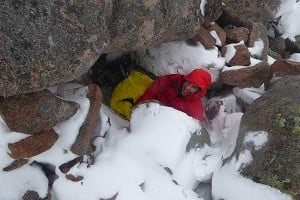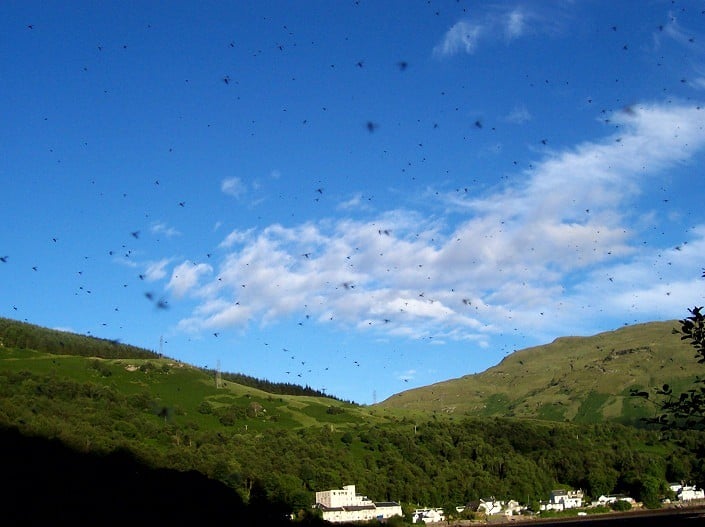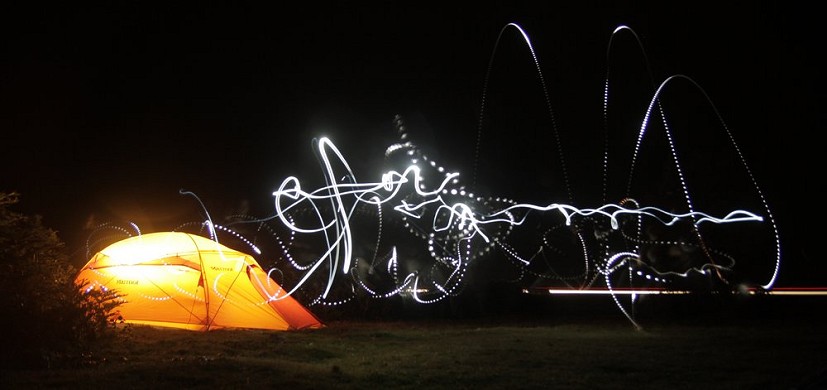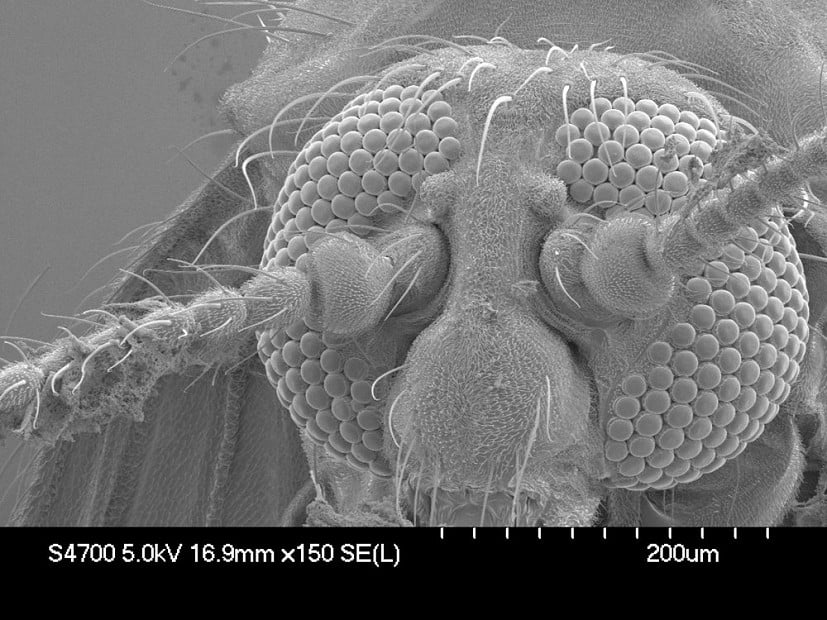
Summer should be an idyllic time out on the hills, but catch it at the wrong moment and it's hell on wings. We're talking midges - in their millions; crawling in your eyes, buzzing up your nose, clouds of them filling your lungs with every breath. You might run, but once the midges have wind of you there's nowhere to hide. Of all the things that can spoil a walk or wild camp - and there aren't many - these are the smallest and easily the most maddening. Scotland may take first prize for the most numerous and ferocious midgies (it's nothing to be proud of), but wherever you go in Britain's summer uplands, from Stanage to Skye, they'll be lurking, just waiting for the right conditions to rise in swarms and send you screaming from the hills. So how do you fend them off? And which times, places and weather conditions should you avoid at all costs? We've suffered for years so that you don't have to. With the caveat that nothing fully works, here's our advice...
Know your enemy
'Midges are tiny insects with a wingspan of just 1-2mm' explains Dr Alison Blackwell of Scottish firm APS Biocontrol, who develop ways to repel and control midges.
'They suck blood from the skin, causing itching and swelling that can last several days. In summer, midges that bite people can reach vast numbers and become a real problem for both locals and tourists.'
'Midges have been around for thousands of years but with climate change they are increasing their range and extending their season, meaning more bites. Biting midges are infamous in the Scottish Highlands, but they are now also found in other parts of the UK, including the Lake District and North Wales.'
'There are nearly 40 species of biting midge in Scotland but only five of these are thought to regularly feed on people. Of these the Highland midge, Culicoides impunctatus (or ‘Meanbh-chuileag’ in Gaelic, meaning ‘tiny fly’), is the most bloodthirsty, and the species responsible for most of the bites of people.'
'[They] target their victims by sensing carbon dioxide in exhaled breath and other odours associated with their targets.
'Midges cause irritation to people, they can spoil a holiday or make it difficult to work, but for other species such as horses and sheep certain species of midge can carry debilitating diseases around the world.'
'Midges can’t be eradicated, but they can be managed on a localised basis with carefully planned trapping and effective repellents.'
Watch the weather
Despite their awesome powers of annoyance midges are surprisingly crap, grounded by anything but the lightest breeze (5mph or more), and not fond of heavy rain or direct sunlight. If you can avoid their preferred calm, humid conditions you'll really improve your chances. And if there's a drought on the hills (not so far this year, but here's hoping) then you may really be in luck.
Check the midge forecast
North of the border a useful addition to weather forecasts is the Scottish Midge Forecast, provided by Dr Alison and colleagues. Published in some newspapers, as an app and online, it predicts activity at specific locations across the country using a combination of midge catch data from a network of traps, and forecast weather conditions. Midge levels are rated from 1 ('negligible') to 5 ('nuisance' - something of an understatement).
Avoid dawn and dusk
Early and late in the day are the midge primetimes. Unfortunately if you're camping then this is when you're generally hanging around pitching tents or eating meals. You can't brew your morning tea inside a zipped tent without risking CO poisoning, so if it's midge hell outside then give up on breakfast, pack everything while you're still safe indoors, strike camp at a sprint and make a run for it. Once you've got somewhere with a bit of breeze it should be safer to stop for brekkie.
Pick your location with care
Whether you're pausing for lunch or pitching camp for the night, try to steer clear of boggy areas, damp woods and sheltered hollows. Unless conditions are stormy you'll really want to make the best of any available breeze, and for this coastal areas tend to beat sheltered inland valleys, while summits are a better bet than cwms and corries.
Dress for maximum protection
It might be hot and sticky, but you're still going to want to cover up. Wear something with long sleeves and a high close-fitting collar, and go for trousers rather than shorts. For the ultimate in midge season style tuck socks into your trouser legs. Stick on a brimmed hat, and over the top of this a midge-proof head net. The net is arguably the most important single piece of summer hillwalking gear. You'll look an idiot, and it's certainly a hindrance when it comes to eating, drinking or even enjoying the view, but when the midges are out in force going net-free really doesn't bear thinking about.
Experiment with repellents
Toxic deet-based mozzie repellents are no protection against a determined midge. Anecdotally some people report limited success with Avon's Skin So Soft moisturiser, though we've found it just makes us unpleasantly slimy to no noticeable effect. Better by far is Smidge, made by Dr Alison's company. Developed in Scotland specifically to counter midges, it's also useful against ticks and horse flies, and while you will still get bitten a bit the difference is very noticeable. But if you find yourself out and about with no chemical assistance to hand, you could always try rubbing yourself with bog myrtle; its insect repelling properties may be more folklore than proven science, but at least you'll smell fragrant while being bitten. In reality nothing yet invented is fully effective.
Tent beats bivvy bag; bothy trumps tent; but proper indoors is best
It's obvious really. Bivvying on a midgey night is a non-starter. Camping might offer some relatively midge-free space, but you're exposed when you pitch the tent, cook or go to the toilet, and when you've sallied forth hangers-on will inevitably follow you back inside. The solid protection of a bothy is clearly preferable, but even these are not always entirely midge-proof, and then there's still the toliet thing. Really, when the midges are having a festival your best bet is to spend evenings in the pub and the night in a hostel or B&B. Or just make life simple and go home before sunset.

We've run out of sensible advice now, but when it comes to ridiculous numbers of midges perhaps only ridiculous solutions will do:
Take up chain smoking
Only joking. But when caught in a full-on swarm you might consider literally anything to ease your suffering, perhaps even at the risk of debilitating disease. Alternatively you could try lighting some anti-bug coils, or (where appropriate) building a fire. At midge scale a puff of smoke is like an asteroid field, a protective cloud of particulates through which they struggle to fly. Well it's nice to tell yourself that anyway.
Recruit an animal bodyguard
You might sometimes hear it said that nothing eats midges, that they are useless in the food chain. It's not true; but if only there was a way to harness their predators. We're thinking air defences, a squadron of tame bats and swifts feasting on your tormentors, with a ground-to-air inner cordon provided by a trained frog on each shoulder.
- INTERVIEW: Exmoor Coast Traverse - England's Best Kept Mountaineering Secret 10 Apr
- REVIEW: Rab Muon 50L Pack 9 Apr
- REVIEW: Boreal Saurus 2.0 22 Mar
- REVIEW: The Cairngorms & North-East Scotland 1 Mar
- REVIEW: Mountain Equipment Switch Pro Hooded Jacket and Switch Trousers 19 Feb
- Classic Winter - East Ridge of Beinn a' Chaorainn 12 Feb
- REVIEW: Salewa Ortles Ascent Mid GTX Boots 18 Jan
- REVIEW: Patagonia Super Free Alpine Jacket 7 Jan
- REVIEW: Deuter Fox - A Proper Trekking Pack For Kids 27 Dec, 2023
- My Favourite Map: Lochs, Rocks, and a Bad Bog 27 Nov, 2023














Comments